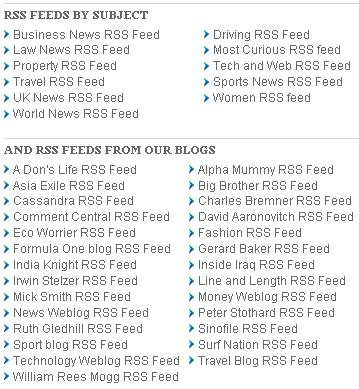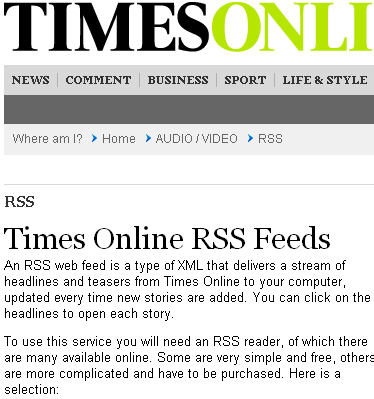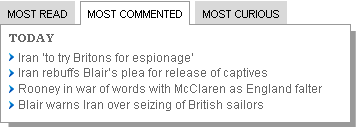Newspapers 2.0: How Web 2.0 is The Times?
I've been doing a survey of British newspaper websites, looking at the extent to which they have incorporated and promote the clutch of technologies that power the Web 2.0 concept - things like RSS feeds, social bookmarking widgets, and blogging platforms.
Yesterday I started the series with a look at the Daily Express, and today I want to look at another newspaper that recently redesigned their online presence, The Times.

RSS feeds
The Times, like the Daily Express, is another paper that offers RSS feeds of content, but doesn't make that fact machine readable from their homepage. In fact, the only mention of The Times feeds is a non-standard icon near the foot of the page in the 'Services and Tools' area called Newsfeeds.

At the time I reviewed the site, they were offering 38 RSS feeds, which included individual feeds of each of their blogs - something that The Daily Express offered as only one composite feed.

RSS can be a difficult concept to get across to new and potential users, and The Times takes a light-hearted approach to explaining it all, which I think works really well.
In the beginning there was the web, and it was good. We fired up our web browsers, entered the site address and navigated ourselves to these wonderful new pages of information and delight. But slowly things began to change. We found that keeping up to date with our growing number of favourite sites was becoming more of a chore than a pleasure. We would spend hours browsing our essential pages and still not be done by lunch, and this was not A Good Thing. Then, just at the point where most of us were about to give it all up in a desperate bid to escape information overload, along came a saviour, a white knight bearing the promise of the age. The RSS standard was born.
...
It’s like having a very efficient butler who cuts out the headlines of your favourite newspaper and serves them to you on a tray, but without the hassle of having to pay holiday benefits.
I have one reservation about the way The Times handles their RSS feed promotion though. The front page uses that non-standard icon and the term 'Newsfeeds', but the page you end up on makes no mention of 'Newsfeeds' at all and just leaps straight in with the term RSS that was seemingly banished from the homepage. Additionally, for some reason, in the hierarchical navigation on the site, the RSS page is filed under 'Audio / Video', when it is quite clearly neither.

Incorporating comments
Stories and opinion pieces on the site carry comments at the bottom of them, although users have to click a "Have your say" link in order to reveal the comment submission form via some DHTML-style goodness. I couldn't help but wonder if that was a cunning ploy to curtail the number of submissions slightly, as my experience from the BBC shows that a large media entity will always attract more comments that it has the time (or energy) to publish.
I did wonder a little bit about the quality of the moderation as well. Clicking on the Terms and Conditions link under the comment submission form bought up what was, in Firefox, a wrongly sized pop-up with Terms and Conditions that were last updated on 30 November, 2004. These appeared to cover the usage of all News International Group web properties, and did not specifically apply to the user-generated comments on The Times.
I was interested since on this piece about the death of Bob Woolmer, The Times has allowed a comment to be published that accuses the Pakistan team of the murder themselves.
Despite the obvious risks, the paper seems keen to encourage this interactivity. A widget on the right-hand side of pages highlights the most read, most curious, and significantly, the most commented upon stories.

There is also a prominent call to action for users to take part in the online debate in the content promotion space in the top right corner of the masthead.

Blogs
The Times is offering quite a range of blogs, and they clearer have a better grip on the concept than some other newspapers. "The Rees-Mogg blog" might be an unavoidable pub, and the content no different to what he would have published in print, but at least with blogs like " Isn't she talking yet?" they've gripped the ideas that part of the flavour of a blog comes out in the name. And calling everything something like "Our football blog" doesn't really do much to engage the blogosphere.
I'm also impressed with Comment Central, a daily blog which doesn't just pull together all the opinion published across The Times, but also provides a compendium of links to comment pieces from across the British online press. It is the kind of thing you imagine the BBC News Magazine should have thought of first, but didn't.
One gripe though, The Times are using Typepad, and so the experience is slightly disjointed as you change domain names and favicons. I'm also unsure whether it is to do with the way that iFrames are implmented to add the global Times navigation to the pages, or the types of adverts currently running on the page, but I have found that when I start visiting The Times blogs, my laptop and browser crawls to an absolute standstill.
Social bookmarking
From a social boomarking point of view, The Times have dipped their collective toe in the water in an unconvincing way.
Stories feature the option to post them to del.icio.us or Newsvine. However, rather like the RSS feed icons on the homepage, it seems that a design decision that all icons must be a graduated blue colour on the site takes precedence over making them recognisable. For that reason, the del.icio.us and Newsvine links almost have the correct branded logos, but in a new Times official blue version
From an aesthetic point of view, I can see why you might want a uniform icon set, but it rather defeats the object of providing instantly recognisable icons for Web 2.0 services if you adapt them to be not quite so recognisable.
This is, perhaps, the least of the problems with the implementation of The Times redesign - their curious CSS coding has already been highlighted and gently teased by Phil Gyford.
Despite providing them on regular stories, The Times doesn't provide any links to social bookmarking sites on their blog pages.
Web 2.0 verdict
The blogs on The Times site seem to have grasped the concept better than most, and by using Typepad are on a solid fully-featured blogging platform. Elsewhere I am less convinced. User recognition of social bookmarking and RSS feeds features are hindered by the use of non-standard icons, for example, and the form to submit comments on a story is initially hidden from view. On the other hand, there are frequent clear calls for user interaction, and the "most read / commented upon / curious" widget dynamically draws attention to the footprints people are leaving as they visit the site.
Next...
In the next part of this series I shall be looking at one of Britain's tabloid "red tops", and seeing how well The Mirror is doing in integrating Web 2.0 features into their site.
As far as I'm concerned, RSS feed provision should - at least - mirror the index structure of your site. So - for example - under sport, there are indexes for football, rugby, motor racing etc etc. So why aren't there RSS feeds offering the same content? It's a major flaw in my opinion, and demonstrates a lack of understanding of how RSS is used.
One other point - for a Celt like myself, one of the best things about the old Times site was that it featured content from the Irish and Scottish editions of the Sunday Times. That content no longer seems to appear.
The latter might raise another interesting question for you Martin - the UK papers put considerable effort into producing variations for the Scottish and Irish markets. And yet none of this is mirrored on their web sites. www.thesun.ie just redirects to www.thesun.co.uk, for example.
I'm mixed on the times makeover. I think they've done a good job visually of cramming lots of information into the football section whilst not making it overbearing, it still has a clean feel to it.
The lack of RSS feeds is particulary disappointing especially when they even had team specific feeds like the BBC previously.
For example I had http://timesonline.co.uk/rssfeed/sportRssIndexFeed/0,,954,00.xml in netvibes which was a valid feed just giving Bolton news, in the makeover this was lost. If you visit the page now it 404's, it would have been nice to issue a redirect so feedreaders would pick up a new URL.
Saying that there doesn't appear to be any new URLs unless I am missing something. There doesn't seem to even be a football RSS feed, only a general sport one.
Here's hoping they bring back team specific RSS feeds. This works well on the BBC whereby if I visit Liverpool they use the correct headers so firefox and IE autodiscover the feed so I can subscribe in one place.
Am also looking forward to team specific podcasts from the major players too as this area is lacking at present